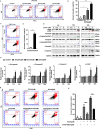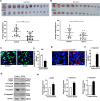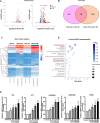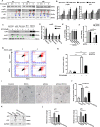A carbazole compound, 9-ethyl-9H-carbazole-3-carbaldehyde, plays an antitumor function through reactivation of the p53 pathway in human melanoma cells
- PMID: 34103468
- PMCID: PMC8187445
- DOI: 10.1038/s41419-021-03867-6
A carbazole compound, 9-ethyl-9H-carbazole-3-carbaldehyde, plays an antitumor function through reactivation of the p53 pathway in human melanoma cells
Abstract
p53, the major tumor suppressor, is frequently mutated in many cancers, and up to 84% of human melanomas harbor wild-type p53, which is considered to be an ideal target for melanoma therapy. Here, we evaluated the antitumor activity of a carbazole derivative, 9-ethyl-9H-carbazole-3-carbaldehyde (ECCA), on melanoma cells. ECCA had a selectively strong inhibitory activity against the growth of BRAF-mutated and BRAF-wild-type melanoma cells but had little effect on normal human primary melanocytes. ECCA inhibited melanoma cell growth by increasing cell apoptosis, which was associated with the upregulation of caspase activities and was significantly abrogated by the addition of a caspase inhibitor. In vivo assays confirmed that ECCA suppressed melanoma growth by enhancing cell apoptosis and reducing cell proliferation, and importantly ECCA did not have any evident toxic effects on normal tissues. RNA-Seq analysis identified several pathways related to cell apoptosis that were affected by ECCA, notably, activation of the p53 signaling pathway. Biochemical assays demonstrated that ECCA enhanced the phosphorylation of p53 at Ser15 in melanoma cells harboring wild-type p53, and importantly, the knockdown or deletion of p53 in those cells counteracted the ECCA-induced apoptosis, as well as senescence. Further investigations revealed that ECCA enhanced the phosphorylation of p38-MAPK and c-Jun N-terminal kinase (JNK), and treatment with either a p38-MAPK or a JNK inhibitor rescued the cell growth inhibition elicited by ECCA, which depended on the expression of the p53 gene. Finally, the combination of ECCA with a BRAF inhibitor significantly enhanced the growth inhibition of melanoma cells. In summary, our study demonstrates that the carbazole derivative, ECCA, induces melanoma cell apoptosis and senescence through the activation of p53 to significantly and selectively suppress the growth of melanoma cells without affecting normal human melanocytes, suggesting its potential to develop a new drug for melanoma therapy.
Conflict of interest statement
The authors declare no competing interests.
Figures







Similar articles
-
A new water soluble MAPK activator exerts antitumor activity in melanoma cells resistant to the BRAF inhibitor vemurafenib.Biochem Pharmacol. 2015 May 1;95(1):16-27. doi: 10.1016/j.bcp.2015.03.004. Epub 2015 Mar 17. Biochem Pharmacol. 2015. PMID: 25795251
-
Fisetin, a phytochemical, potentiates sorafenib-induced apoptosis and abrogates tumor growth in athymic nude mice implanted with BRAF-mutated melanoma cells.Oncotarget. 2015 Sep 29;6(29):28296-311. doi: 10.18632/oncotarget.5064. Oncotarget. 2015. PMID: 26299806 Free PMC article.
-
Combining an Aurora Kinase Inhibitor and a Death Receptor Ligand/Agonist Antibody Triggers Apoptosis in Melanoma Cells and Prevents Tumor Growth in Preclinical Mouse Models.Clin Cancer Res. 2015 Dec 1;21(23):5338-48. doi: 10.1158/1078-0432.CCR-15-0293. Epub 2015 Jul 7. Clin Cancer Res. 2015. PMID: 26152738 Free PMC article.
-
A Review on the Anticancer Activity of Carbazole-based Tricyclic Compounds.Curr Med Chem. 2024;31(30):4826-4849. doi: 10.2174/0929867331666230825104254. Curr Med Chem. 2024. PMID: 37622700 Review.
-
Differentiation therapy and the mechanisms that terminate cancer cell proliferation without harming normal cells.Cell Death Dis. 2018 Sep 6;9(9):912. doi: 10.1038/s41419-018-0919-9. Cell Death Dis. 2018. PMID: 30190481 Free PMC article.
Cited by
-
Sialidase NEU1 May Serve as a Potential Biomarker of Proliferation, Migration and Prognosis in Melanoma.World J Oncol. 2022 Aug;13(4):222-234. doi: 10.14740/wjon1509. Epub 2022 Aug 23. World J Oncol. 2022. PMID: 36128592 Free PMC article.
-
Maintaining Genome Integrity: Protein Kinases and Phosphatases Orchestrate the Balancing Act of DNA Double-Strand Breaks Repair in Cancer.Int J Mol Sci. 2023 Jun 16;24(12):10212. doi: 10.3390/ijms241210212. Int J Mol Sci. 2023. PMID: 37373360 Free PMC article. Review.
-
Phenformin activates ER stress to promote autophagic cell death via NIBAN1 and DDIT4 in oral squamous cell carcinoma independent of AMPK.Int J Oral Sci. 2024 May 8;16(1):35. doi: 10.1038/s41368-024-00297-w. Int J Oral Sci. 2024. PMID: 38719825 Free PMC article.
References
Publication types
MeSH terms
Substances
Grants and funding
- 2018GSF118240/Department of Science and Technology of Shandong Province
- ZR2019ZD36/Department of Science and Technology of Shandong Province
- ZR2019ZD36/Department of Science and Technology of Shandong Province
- ZR2019ZD36/Department of Science and Technology of Shandong Province
- 2019GSF108107/Department of Science and Technology of Shandong Province
LinkOut - more resources
Full Text Sources
Medical
Molecular Biology Databases
Research Materials
Miscellaneous

